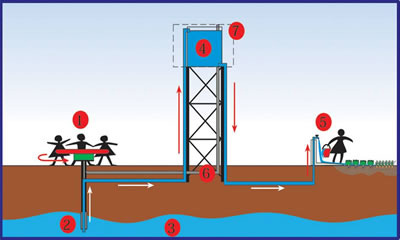Once in a while, technologies that are meant to change the world emerge, but turn out to be nothing but hot air. In fact, many end up making bad problems worse, or deviating much needed resources from the areas where they are most needed. This has happened severally in the development world, as shown by these two examples.
The PlayPump
In 2010, an idea to build a water pump that was connected and powered by a merry go round won the World Bank’s Development Marketplace award. The pump would be installed in remote places in Africa and when children played on the merry go round, water would be pumped to a storage tank for later use by the community.
This caught the eye – or better, the pockets – of various celebrities and world leaders including Jay-Z, Laura Bush and Bill Clinton, resulting to millions of monies in funding. It was supposed to be the pump that completely transforms remote African villages by giving people access to clean water.

What happened to the playpump? It was a total failure.
As soon as the pumps were launched, several challenges showed up. The worst of them was the sheer amount of time that children needed to play to make the pump viable. In some communities, children would be expected to play for up to 27 hours every day to meet the expected water needs of the community. For the children, playing was no longer a fun and spontaneous activity, but hard work to get water into the storage tanks.
The pumps were more expensive than the conventional hand pumps and were very expensive to maintain. Most communities had neither the expertise nor the spare parts needed to repair them, hence would fall into disuse once they broke down. Obviously, children get tired and also need to go to school, forcing women to turn the pumps by hand in order to get water. It also needed several women to turn, hence more complicated than existing hand pumps.
One Laptop Per Child
In 2005, a professor at MIT came up with an idea of developing the most rugged laptop that would cost $100, and would be used in third world country to help students learn.
These laptops would be unbreakable, would not need access to electricity, would be owned by students and would encourage students to study.
It was a poetic story that was sold to donors, with promises that laptops loaded with hundreds of books would be dropped from helicopters so that poor children in developing world could access them.
The failure was big.

Almost all the promises made were not kept. The final product was a basic laptop which had less computing power than existing smartphones. They cost $180, and in the process of trying to make the cheap, they made them extremely hard to repair. They needed electricity to operate, and they would also break easily.
Experts from developing countries had warned that there were more pressing needs than laptops, but the proponents of the project were so busy selling their poetic idea and never listened.
The project failed. Those that were sent to schools in Latin America largely remained in boxes and original packages because even teachers did not know how to use them.
Learning From the Failures
The problem was that both the playpump and 1 tablet per child projects pleased donors, and the flashy idea were not practical or sustainable. With money from different sources, the projects went ahead to full deployment and failure was dismal.
This should be a caution to people developing products that are appealing to many, and assume that they will be adopted by the masses. It calls for engineers and entrepreneurs to venture into thorough research before throwing resources into solutions that no one needs or will never work.
Unfortunately, many people never learn, and when you advise someone that no one will ever install the app they desperately want to build, they opt to go forward with it until they see it practically fail. They prefer to learn from their own experience.
Before you get excited about that cool idea you have, find time to do some serious research. Talk to the experts, ordinary people, potential users and most importantly, the critics.



What do you think?